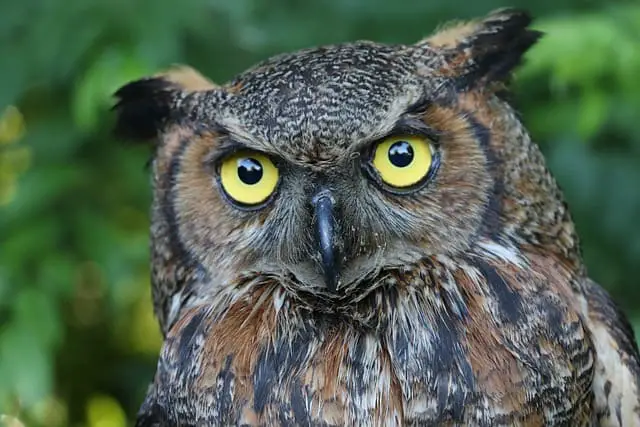Great horned owls (Bubo virginianus) are large birds of prey that are also called tiger owls or hoot owls. They are among the largest owls in any of the three American continents. These large owls are the most widely distributed true owl in the western hemisphere. Their range stretches from northern Canada and Alaska in North America to the southernmost tip of Argentina in South America.
Great horned owls are the most common owls in North America and are among the largest owls in any of the three American continents. They are the largest owls in Central America and South America. On the other hand, they are the second heaviest owl behind the snowy owl in North America.
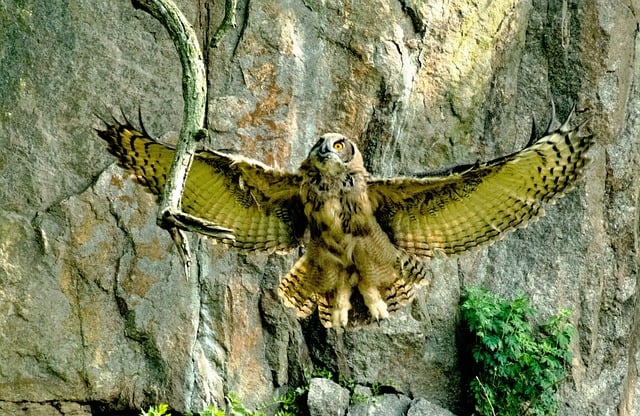
Just exactly how big do great horned owls get?
The heaviest great horned owl ever measured weighed 5.518 lbs. However, an average adult great horned owl’s body weight is 3.545 lbs (1,608 g) for females and 2.698 lb. (1,224 g) for males.
They are anywhere from 17 to 25 inches (43 to 64 cm) long. This gives them an average length of 22 inches (55 cm). Their wingspan ranges from 3 ft to 5 ft (91 to 153 cm). That gives them an average wingspan of 48 inches (122 cm).
Regional differences, slight variations in sub-species, and sexual dimorphism ” females are larger than males” are all factors that create discrepancies in their average size.
As to regional differences and differences in sub-species, Bergman’s rule, in a nutshell, states that the largest individuals of any organism will be found at the coldest latitudes. This holds true with great horned owls.
The largest great horned owl sub-species is the Sub-Arctic Great Horned Owl (Bubo Virginianus Subarcticus) which ranges from the tree line in Canada and Alaska southward into parts of Montana, Wyoming, and North Dakota.
On the other hand, Yucatán great horned owls (Bubo virginianus mayensis), which are year-round residents of Mexico’s Yucatan Peninsula, are the smallest subspecies of great horned owls.
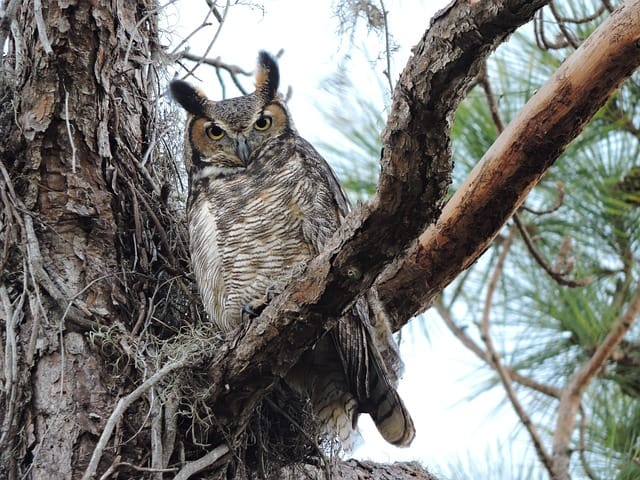
What do great horned owls look like?
These birds have a proportionally large head with large yellow eyes that are forward facing. Interestingly owls cannot move their eyes because they are tubular in shape instead of spherical and do not move in their sockets like human eyes do, for example.
Instead, they have the ability to rotate their heads up to 270 degrees to scan their surroundings.
Additionally, they have prominent ear tufts that poke up above each side of the top of their head, resembling horns. Consequently, this gives impetus to their name. These tufts of feathers are called plumicorns. Ornithologists are not certain what purpose plumicorns serve. However, they theorize that they serve as a status symbol in their interactions with other owls.
The coloration of a great horned owl’s plumage serves as camouflage. Their underparts are generally white with horizontal tan or brown barring. They are mottled light and darker brown colored on top. All great horned owl sub-species have dark baring along the sides. They also have a white throat patch that transitions into a streak down the center of the breast in some sub-species.
Like all owls, the great-horned owl has a facial disk. A facial disk is, by definition, a concave clustering of feathers on the face and surrounding the eyes. On birds of prey, the facial disk serves to gather and direct sound waves toward the ears.
A great horned owl’s facial disk is either gray or reddish brown, depending on the geographic location and sub-species.
Like most owls, great horned owls have feathered legs and feet. Beneath the feathers, their feet and legs are grey.
These birds have powerful feet. In fact, their grip strength is similar to that of a bald eagle. They can exert a maximum of around 500 psi when they choose to.
Great horned owl behavior
Great horned owls are predominantly nocturnal birds. They primarily hunt from a perch, waiting to silently swoop down on their prey. On the other hand, they mostly spend the daylight hours roosting in tree cavities, cracks in cliff faces, or other sheltered areas.
In North America, the red-tailed hawk shares similar habitat with the great horned owl, and this species is their diurnal counterpart. In fact, these two raptor species are not only nocturnal and diurnal counterparts, but they’re also mortal enemies.
Great horned owls are natural predators of red-tailed hawks. They sometimes swoop down on and attack them from above when they’re roosting. What’s more, they sometimes knock red-tails or peregrine falcons off their nests to steal their eggs or kill their chicks. On the other hand, red-tailed hawks will not bypass the opportunity to kill young owls when it presents itself.
These two raptors also battle over nest sites. Great horned owls can and do build their own nests. However, they sometimes take over stick nests that were constructed by other birds, such as red-tailed hawks.
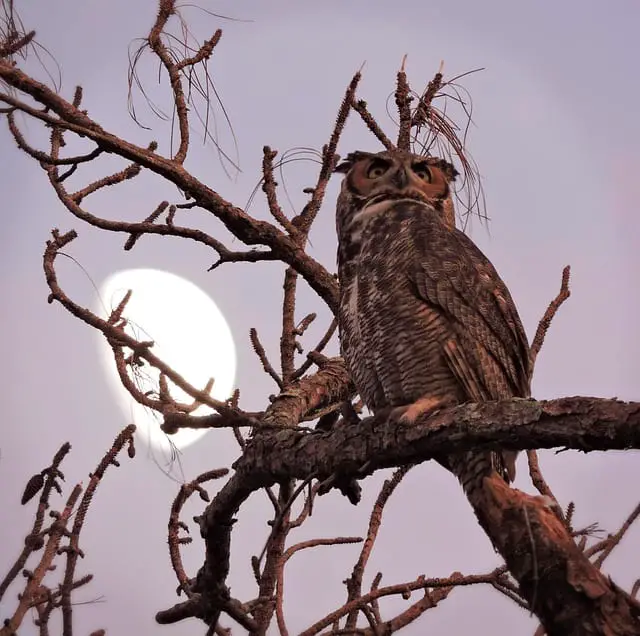
Reproductive behavior
Great horned owls are extremely early nesters. Their mating season is in January and early February. Consequently, this is the best time to hear them hooting to each other.
Great horned owl pairs are monogamous and often stay together for years.
The female great horned owl may lay her clutch which will consist of 1 to 5 eggs. Great horned owls sometimes use abandoned squirrel nests or the nests of other birds. The pair might also construct their own nest. Cliff ledges and hollow trees are prime nesting sites for them. See
The female does all the incubating of the eggs while the male provides her with food. Their incubation period lasts for 30 to 37 days.
Newly hatched, great horned owlets are covered in down. They are born with sealed eyes and will have for about a week. They make rapid developmental changes and are ready to leave the nest for short flights at 6 to 9 weeks of age.
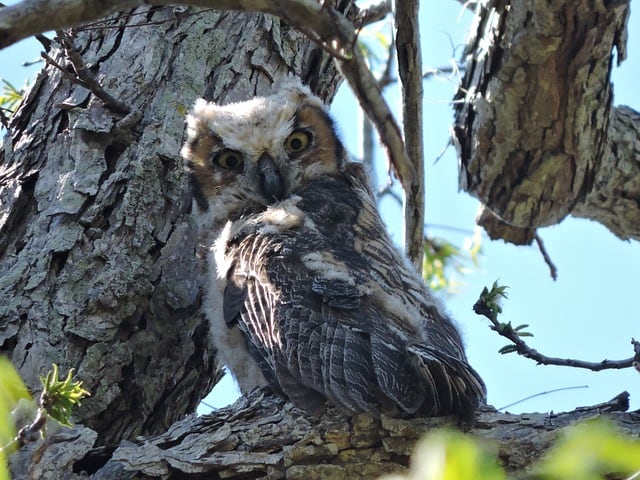
Protective parents
There is a reason that great horned owls are called feathered tigers. They are fierce predators, but they also fiercely protect their young. The following is a quote from an article on The Centre for the Conservation of Specialized Species website on sub-arctic great horned owls found here
“At about six weeks of age, the young tumble from their nest, usually unharmed; as they must in order to have room to move about and exercise their developing flight muscles. Throughout the nesting period, the parents are often extremely protective of their young. They can be very dangerous to encounter while nesting, and many people have been severely attacked by this species when it is in defence of its young. The first indication that a person is too close to this owl’s nest or young is that the owls will hiss and snap their beaks in a rapid and very menacing manner, while they puff out all their plumage and fan their wings over their back to appear many times their actual size.
Next, if the onlooker does not withdraw, one or both owls will disappear into the surrounding forest, only for one of them to silently reappear directly behind the person or animal that is perceived to be a threat. The eight talons are driven in their full depth which is up to 5.08 cm (two inches), then the owl tightens its fearsome grip. A lot of tissue damage can occur very quickly as the owl twists and tears the flesh. The moment that one of the parent owls releases its grip, the other attacks, completely silently, from the opposite side in exactly the same manner. As the owls grow even more bold, one of them will drop to the ground and flip over upon its back and tail feathers, then will quickly thrust it’s talons deep into the underbelly, or in the case of humans: into the crotch of the attacker. This incredible defence of the young will continue until the threat to their nesting efforts either flees, or is killed. Even adult Black bears have been attacked and driven off by such menacing behaviour. It is plain to see why this owl earned the name of feathered tiger!”
Great horned owl diet.
Great horned owls use their large size to great advantage. They are fierce predators and eat a wide variety of prey over their extended range in North, Central, and South America. In fact, ornithologists have identified over 500 different species as great horned owl prey.
However, in the United States and Canada, a great horned owl’s diet narrows down considerably. A handful of small mammals take up the biggest majority of their diet. They largely live on eastern cotton tail rabbits, black-tailed jackrabbits, snowshoe hares, whited-footed mice, North American deer mice, meadow voles, prairie voles, woodland voles, and brown rats.
That’s the majority of their diet. However, they also prey on birds, including other raptors such as red-tailed hawks and barn owls, reptiles such as lizards, snakes, and young alligators, and large insects.
They eat smaller prey whole, such as small rodents and small birds. On the other hand, they have to take larger prey, such as a rabbit, to a perch where they tear it apart and eat it in pieces. After they eat small prey whole, they regurgitate whatever undigested material that they have eaten, such as bones, teeth, claws, feathers, and hair, in the form of cylindrically shaped gray pellets that are 3 to 4 inches long and about an inch and a half in diameter.
Recent Posts
The only venomous snakes in Washington State are Northern Pacific Rattlesnakes. The Northern Pacific Rattlesnake (Crotalus oreganus oreganus) is a sub-species of the Western Rattlesnake. Anyone...
Skunks are not classified as true hibernators. But they go into a state of torpor when the weather gets cold. Skunks are light sleep hibernators, along with opossums, bears, and raccoons. ...

